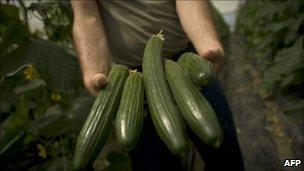E. coli outbreak in Germany: Women more affected
- Published

German officials say they are no longer sure Spanish cucumbers are the source of the outbreak
One of the mysteries about the outbreak of the particularly vicious strain of E. coli is that most of the victims have been women.
In most outbreaks, the victims are children because they have not developed the immune system to fight off the food poisoning - but in the German case, it is adults and female adults, in particular.
Scientists simply do not know why.
One theory was that the victims were often people who liked eating what they thought was healthy food, say because it was low calorie (like cucumbers) or because it was organic.
But the scientists are now cautioning against that view. It may be too pat.
Dr Ulf Goebel of the Charite university hospital in Berlin said it might just be that this specific strain had something in it which found women's bodies suitable and not men's (just as some strains work on some ethnic groups and not others).
Intriguingly, a previous outbreak of this rare type of E. coli happened in the United States in 1994 - and again the victims were predominantly women, with the average victim being 36 years of age.
DNA tests
If it is simply that women are more susceptible to this particular type of E. coli, then that would point away from the "health food" theory.
As if to confuse matters further, the German authorities, having pointed the finger at Spain earlier, said tests on the suspect cucumbers had shown a trace of a different strain of E. coli - in other words: the cucumbers were not guilty of causing the current outbreak.
All this matters greatly because once a country's farms are tainted, trade collapses. Information affects livelihoods, which explains the outrage in Spain at German accusations.
There is some dismay in other cucumber-growing countries too.
A lack of clarity serves to put a cloud of suspicion over many. Some consumers simply shy away from the suspect vegetable without making a distinction about source.
So the task of getting clarity is urgent.
There is an immense amount of extraordinarily clever work going into identifying the source, like studying the DNA of the bacterium.
But the true breakthrough will come, Dr Goebel says, through what amounts to detective work: simply asking all the surviving victims what they ate and when they ate it, and then comparing notes to find a pattern.
Simple, really - or not.
- Published29 May 2011
- Published25 May 2011
- Published7 January 2011